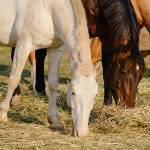Selecting Hay: Type of Grass, Timing of First Cut Are Considerations for Many Horses

When shopping for hay, many horse owners ask about time of harvest, specifically what “cutting” a batch of hay may be. Is the hay the first harvest from a field, known as the first cutting, or is it the second or third? Horse owners should consider their horses’ health concerns when choosing an appropriate hay, including the cutting.
If, for example, horses have insulin dysregulation/equine metabolic syndrome (ID/EMS) or pituitary pars intermedia dysfunction (PPID, previously known as Cushing’s), then hay buyers should pay attention to both grass species and timing of first cut, as these factors can affect the concentration of nonstructural carbohydrates (NSCs).
Grass forage consists of two main types of carbohydrates. One is structural carbohydrates, such as cellulose, that make up the cell walls of plants and are fermented in the hindgut. This fermentation process produces volatile fatty acids, which are important energy sources for horses.
“The other form, NSCs, include starch, simple sugars like glucose, and fructans. Cool-season grasses, such as timothy and orchardgrass, typically have greater concentrations of fructans compared to warm-season grasses, such as bermudagrass and teff, so cool-season grasses often have greater NSC concentrations,” explained Ashley Fowler, Ph.D., a nutritionist for Kentucky Equine Research.
Sugars are produced by photosynthesis and are used as energy for the growth and development of the plant. When simple sugars are produced in excess, they are stored in long chains called polymers. Fructan is made of polymers of fructose and is the major storage form of NSCs in cool-season grasses. Starch is another storage form of simple sugars (i.e., glucose) but is generally lower in grass tissue and is the main storage form for seeds and grains.
High consumption of fructans has been linked to hindgut acidosis and laminitis, and consuming excess NSCs can be problematic for horses with ID/EMS and PPID.
“Horses with ID/EMS, PPID, and even polysaccharide storage myopathy (PSSM), should be fed forages with less than 10% NSC,” Fowler recommended.
In a recent study, a European research team evaluated the carbohydrate content of six different cool-season grasses at the time of an early, mid, or late first cut.* Grass species used in this study included meadow fescue, cocksfoot (also known as orchardgrass), perennial ryegrass, smooth bromegrass, tall fescue, and timothy. Early first cut was June 4th, mid cut was June 17th, and late cut was July 1st.
The maturity of the grasses was expected to increase with harvest time.
“Both grass species and harvesting time affected the composition of the grasses. Importantly, the water-soluble (sugar) content increased in smooth bromegrass and timothy but decreased in orchardgrass as they matured,” Fowler said.
Water-soluble carbohydrates (WSCs) are the simple sugar components of NSCs as well as fructans.
Further, fructans increased in smooth bromegrass, timothy, perennial ryegrass, and tall fescue as the grass matured, but not in orchardgrass or meadow fescue.
“Both orchardgrass and meadow fescue had WSC concentrations lower than 15%, regardless of harvest time. These forages may be suitable for horses with endocrinopathies or PSSM. However, orchardgrass palatability can be lower than other grass species,” Fowler explained.
If feeding forages higher in WSCs is the only option, then an earlier first cut may contain lower WSCs compared to a later first cut. But, early first cuts have higher overall digestibility, meaning that such grasses have higher energy values. Excess energy may be undesirable for horses with low energy requirements or easy keepers but may be beneficial for horses with higher energy requirements, such as performance horses or broodmares.
“Overall, this study shows that not every horse’s diet can be formulated using ‘average’ or ‘book values’ for NSC concentrations and that even choice of grass species and timing of first harvest can affect hay nutrient composition,” summarized Fowler.
If your horse requires a low-NSC diet, it is important to have each batch of hay tested for NSC content. If low-NSC hay cannot be sourced, soaking the hay before feeding is an effective way to reduce sugar content.
“Hay soaking, however, can also reduce required minerals, so be sure to include a ration balancer or vitamin-mineral supplement in the diet,” advised Fowler.
*Stang, F.L., R. Bjerregaard, C.E. Müller, A. Ergon, M. Halling, N.W. Thorringer, A. Kidane, and R.B. Jensen. 2023. The effect of harvest time of forage on carbohydrate digestion in horses quantified by in vitro and mobile bag techniques. Journal of Animal Science 101:skac422. doi:10.1093/jas/skac422








